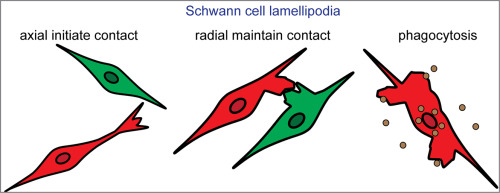Molecular and Cellular Neuroscience ( IF 2.6 ) Pub Date : 2018-01-11 , DOI: 10.1016/j.mcn.2018.01.001 Johana Tello Velasquez , James A. St John , Lynn Nazareth , Jenny A.K. Ekberg

|
Lamellipodia in Schwann cells (SCs) are crucial for myelination, but their other biological functions remain largely uncharacterised. Two types of lamellipodia exist in SCs: axial lamellipodia at the outermost edge of the cell processes, and radial lamellipodia appearing peripherally along the entire cell. We have previously shown that radial lamellipodia on olfactory glia (olfactory ensheathing cells; OECs) promote cell-cell adhesion, contact-mediated migration and phagocytosis. Here we have investigated whether lamellipodia in SCs have similar roles. Using live-cell imaging, we show that the radial lamellipodia in SCs are highly motile, appear at multiple cellular sites and rapidly move in a wave-like manner. We found that axial and radial lamellipodia had strikingly different roles and are regulated by different intracellular pathways. Axial lamellipodia initiated interactions with other SCs and with neurons by contacting radial lamellipodia on SCs, and budding neurites/axons. Most SC-SC interactions resulted in repulsion, and, lamellipodial activity (unlike in OECs) did not promote contact-mediated migration. We show that lamellipodia are crucial for SC-mediated phagocytosis of both axonal debris and bacteria, and demonstrated that inhibition of lamellipodial activity by blocking the Rho/Rac pathways also inhibits phagocytosis. We also show that heregulin, which induces SC differentiation and maturation, alters lamellipodial behaviour but does not affect phagocytic activity. Overall, the results show that SC lamellipodia are important for cell interactions and phagocytosis.
中文翻译:

雪旺细胞层状脂蛋白调节细胞-细胞相互作用和吞噬作用
雪旺细胞(SCs)中的Lamellipodia对于髓鞘形成至关重要,但它们的其他生物学功能仍未完全表征。SC中存在两种类型的薄片状脂溢:在细胞过程最外缘的轴向薄片状脂溢和在整个细胞周围出现的径向薄片状脂溢。先前我们已经表明,嗅神经胶质细胞(嗅鞘细胞; OEC)上的放射状片状脂溢会促进细胞与细胞的粘附,接触介导的迁移和吞噬作用。在这里,我们研究了SC中的lamellipodia是否具有相似的作用。使用活细胞成像,我们显示,SC中的放射状片状脂溢是高度运动的,出现在多个细胞部位,并以波状方式快速移动。我们发现轴向和径向板状脂膜瘤具有显着不同的作用,并受到不同的细胞内途径的调节。轴向条状脂蛋白通过使放射状条脂蛋白在SCs上接触并萌发神经突/轴突而开始与其他SC以及与神经元的相互作用。大多数SC-SC相互作用都会导致排斥,并且片状脂质体活动(与OEC中不同)不会促进接触介导的迁移。我们表明,lamellipodia对于轴突碎片和细菌的SC介导的吞噬作用至关重要,并证明通过阻止Rho / Rac途径抑制lamellipodial活性也能抑制吞噬作用。我们还表明,调蛋白,它诱导SC分化和成熟,改变薄片脂肪的行为,但不影响吞噬活性。总体而言,结果表明,SC片状脂溢性菌对于细胞相互作用和吞噬作用很重要。和萌芽的神经突/轴突。大多数SC-SC相互作用都会导致排斥,并且片状脂质体活动(与OEC中不同)不会促进接触介导的迁移。我们表明,lamellipodia对于轴突碎片和细菌的SC介导的吞噬作用至关重要,并证明通过阻止Rho / Rac途径抑制lamellipodial活性也能抑制吞噬作用。我们还表明,调蛋白,它诱导SC分化和成熟,改变薄片脂肪的行为,但不影响吞噬活性。总体而言,结果表明,SC片状脂溢性菌对于细胞相互作用和吞噬作用很重要。和萌芽的神经突/轴突。大多数SC-SC相互作用都会导致排斥,并且片状脂质体活动(与OEC中不同)不会促进接触介导的迁移。我们表明,lamellipodia对于轴突碎片和细菌的SC介导的吞噬作用至关重要,并证明通过阻止Rho / Rac途径抑制lamellipodial活性也能抑制吞噬作用。我们还表明,调蛋白,它诱导SC分化和成熟,改变薄片脂肪的行为,但不影响吞噬活性。总体而言,结果表明,SC片状脂溢性菌对于细胞相互作用和吞噬作用很重要。我们表明,lamellipodia对于轴突碎片和细菌的SC介导的吞噬作用至关重要,并证明通过阻止Rho / Rac途径抑制lamellipodial活性也能抑制吞噬作用。我们还表明,调蛋白,它诱导SC分化和成熟,改变薄片脂肪的行为,但不影响吞噬活性。总体而言,结果表明,SC片状脂溢性菌对于细胞相互作用和吞噬作用很重要。我们表明,lamellipodia对于轴突碎片和细菌的SC介导的吞噬作用至关重要,并证明通过阻止Rho / Rac途径抑制lamellipodial活性也能抑制吞噬作用。我们还表明,调蛋白,它诱导SC分化和成熟,改变薄片脂肪的行为,但不影响吞噬活性。总体而言,结果表明,SC片状脂溢性菌对于细胞相互作用和吞噬作用很重要。











































 京公网安备 11010802027423号
京公网安备 11010802027423号